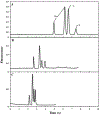High-performance microchip electrophoresis separations of preterm birth biomarkers using 3D printed microfluidic devices
- PMID: 37595419
- PMCID: PMC10473225
- DOI: 10.1016/j.chroma.2023.464242
High-performance microchip electrophoresis separations of preterm birth biomarkers using 3D printed microfluidic devices
Abstract
We employed digital light processing-stereolithography 3D printing to create microfluidic devices with different designs for microchip electrophoresis (µCE). Short or long straight channel, and two- or four-turn serpentine channel microfluidic devices with separation channel lengths of 1.3, 3.1, 3.0, and 4.7 cm, respectively, all with a cross injector design, were fabricated. We measured current as a function of time and voltage to determine a separation time window and conditions for the onset of Joule heating in these designs. Separations in these devices were evaluated by performing µCE and measuring theoretical plate counts for electric field strengths near and above the onset of Joule heating, with fluorescently labeled glycine and phenylalanine as model analytes. We further demonstrated µCE of peptides and proteins related to preterm birth risk, showing increased peak capacity and resolution compared to previous results with 3D printed microdevices. These results mark an important step forward in the use of 3D printed microfluidic devices for rapid bioanalysis by µCE.
Keywords: 3D printing; Microchip electrophoresis; Microfabrication; Microfluidics; Preterm birth biomarkers.
Copyright © 2023 Elsevier B.V. All rights reserved.
Conflict of interest statement
Declaration of Competing Interest The authors declare the following financial interests/personal relationships which may be considered as potential competing interests GPN and ATW own shares in Acrea3D, a company that is commercializing 3D printers. The other authors have no conflicts to declare
Figures






Similar articles
-
3D printed microfluidic devices for integrated solid-phase extraction and microchip electrophoresis of preterm birth biomarkers.Anal Chim Acta. 2024 Apr 1;1296:342338. doi: 10.1016/j.aca.2024.342338. Epub 2024 Feb 5. Anal Chim Acta. 2024. PMID: 38401930 Free PMC article.
-
3D printed microfluidic device for automated, pressure-driven, valve-injected microchip electrophoresis of preterm birth biomarkers.Mikrochim Acta. 2022 Apr 28;189(5):204. doi: 10.1007/s00604-022-05303-8. Mikrochim Acta. 2022. PMID: 35484354 Free PMC article.
-
3D Printed Microfluidic Devices for Microchip Electrophoresis of Preterm Birth Biomarkers.Anal Chem. 2019 Jun 4;91(11):7418-7425. doi: 10.1021/acs.analchem.9b01395. Epub 2019 May 14. Anal Chem. 2019. PMID: 31056901 Free PMC article.
-
Advancing Tissue Culture with Light-Driven 3D-Printed Microfluidic Devices.Biosensors (Basel). 2024 Jun 8;14(6):301. doi: 10.3390/bios14060301. Biosensors (Basel). 2024. PMID: 38920605 Free PMC article. Review.
-
3D Printed Microfluidics.Annu Rev Anal Chem (Palo Alto Calif). 2020 Jun 12;13(1):45-65. doi: 10.1146/annurev-anchem-091619-102649. Epub 2019 Dec 10. Annu Rev Anal Chem (Palo Alto Calif). 2020. PMID: 31821017 Free PMC article. Review.
Cited by
-
3D Printed Microfluidic Devices for Integrated Immunoaffinity Extraction, Solid-Phase Extraction, and Fluorescent Labeling of Preterm Birth Biomarkers.Precis Chem. 2025 Mar 3;3(5):261-271. doi: 10.1021/prechem.4c00092. eCollection 2025 May 26. Precis Chem. 2025. PMID: 40443764 Free PMC article.
-
Bipolar electrochemically generated fluorescence detector for microchip electrophoresis with and without a potentiostat: Application to reducible analyte detection.Sens Actuators Rep. 2025 Jun;9:100283. doi: 10.1016/j.snr.2025.100283. Epub 2025 Jan 14. Sens Actuators Rep. 2025. PMID: 40303948 Free PMC article.
-
Compact 3D-Printed Unit for Separation of Simple Gas Mixtures Combined with Chemiresistive Sensors.Sensors (Basel). 2024 Jul 6;24(13):4391. doi: 10.3390/s24134391. Sensors (Basel). 2024. PMID: 39001169 Free PMC article.
-
3D printed microfluidic devices for integrated solid-phase extraction and microchip electrophoresis of preterm birth biomarkers.Anal Chim Acta. 2024 Apr 1;1296:342338. doi: 10.1016/j.aca.2024.342338. Epub 2024 Feb 5. Anal Chim Acta. 2024. PMID: 38401930 Free PMC article.
References
-
- Akyazi T, Gil-González N, Basabe-Desmonts L, Castaño E, Morant-Miñana M, Benito-Lopez F, Manipulation of fluid flow direction in microfluidic paper-based analytical devices with an ionogel negative passive pump, Sensors and Actuators B: Chemical 247 (2017) 114–123.
MeSH terms
Substances
Grants and funding
LinkOut - more resources
Full Text Sources

